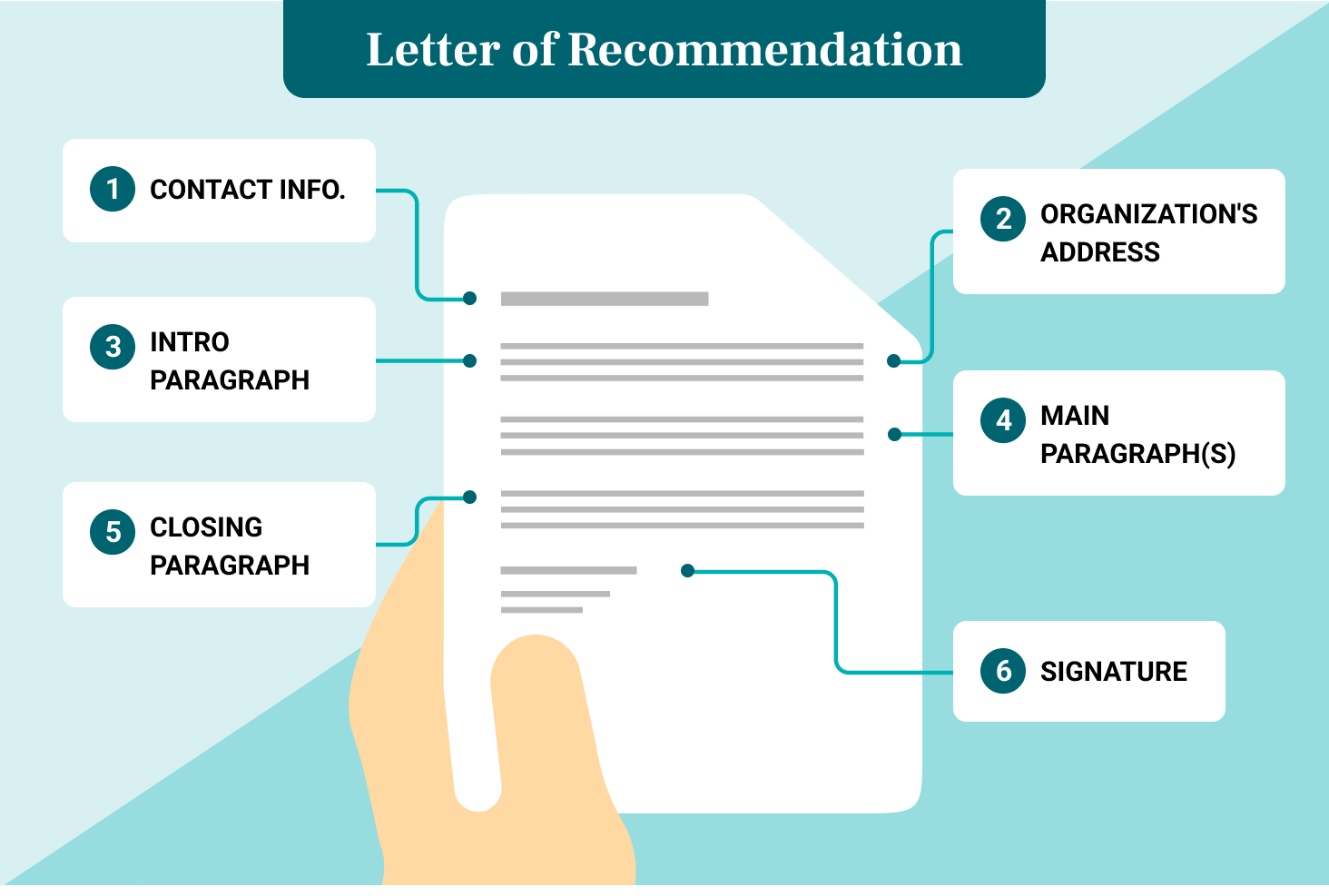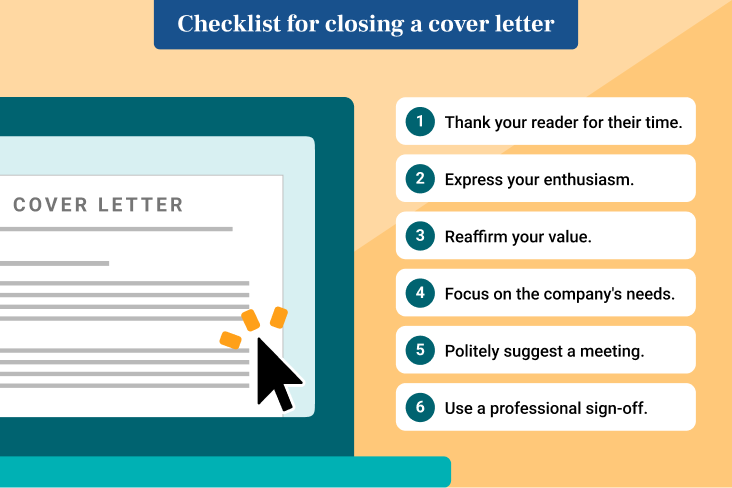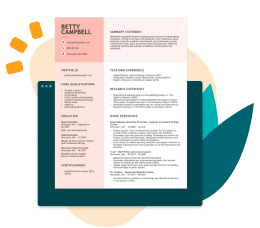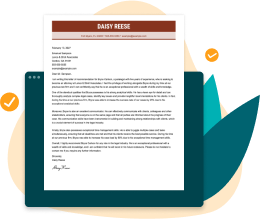A strong letter of recommendation can be the deciding factor in whether a job seeker lands an offer. Whether you need one or are writing one for a colleague, this guide will show you how to craft a letter that adds real value and demonstrates professionalism. Let’s get started!
What Is a Letter of Recommendation?
A letter of recommendation is a formal document written on behalf of someone else, attesting to their qualifications and skills for a potential job or internship. Usually, former employees, colleagues, or students request letters of recommendation.
Providing one of these letters is like serving as a resume reference, except that you communicate in written form and not over the telephone.
A letter of recommendation is similar in structure to a cover letter. It should fit onto one page and include your contact info, the recipient’s address, a greeting, three paragraphs, and a sign-off.
If someone asks for this type of recommendation note, they probably expect you to say positive things about them. If you feel uncomfortable recommending this person or lack the time to help, politely decline the request.
The structure of a letter of recommendation follows that of a traditional business letter. To write a professional letter of recommendation that makes a positive impact on the reader, ensure you include the following sections in this order:
- Your contact information: Include your name, phone number, location (city and state), and the letter’s date. You may also include your employer’s name, but this is optional.
- The organization’s address and the recipient’s information: Following the standard business letter format, include the recipient’s name, company name, address, and a formal greeting like “Dear Hiring Manager.”
- Introduction paragraph: Introduce yourself with your relation to the applicant, and mention them by name as well as the role they’re applying for.
- Body paragraph: Share the most relevant reasons why the employer should consider the applicant for the work opportunity and provide concrete examples of their accomplishments.
- Closing paragraph: Wrap up with your final thoughts on the applicant’s qualifications and prompt the reader to extend them an interview or job offer.
- Signature: Close your letter of recommendation with a simple salutation and your name. A signature is optional, but a nice touch.
Template for Letter of Recommendation
You can copy and paste this recommendation letter template and personalize it with information about the person you’re recommending.
Recommendation letter template
[Your Name]
[Optional: Company name]
[Street Address]
[City, State ZIP code]
[Phone number]
[Email address]
[Date]
[Receiver’s Name]
[Receiver’s Title]
[Receiver’s Organization]
[Receiver’s Street Address]
[City, State ZIP Code]
Dear [Receiver’s Name] / Hiring Manager,
With great enthusiasm, I am writing to recommend [Applicant Name] for [Role] at [Organization]. My name is [Your Name], and I serve as a [Your Role] at [Your Organization]. For [length of time], I had the pleasure of working with [Applicant’s First Name] while [explain how you worked together]. What stands out about [Applicant First Name] is [two or three top qualities about the applicant].
During our time together, [Applicant First Name] showed [list one or two skills] that led to [specific achievement]. [Insert story explaining your shared goals and how you reached them.] Given [his/her/their] excellent work ethic and passion for [specific Organization focus], I feel confident [Applicant Name] would be an ideal fit for [Your Organization].
Thank you for your time in reading this. Feel free to contact me if you have any questions or want to discuss [Applicant Name]’s talents or abilities.
Sincerely,
[Your Name]
[Your Title]
Letter of recommendation sample
Here’s an example of how you can personalize the template above into a convincing letter:
Lolita Mend
Head Nurse
Evergreen Hospital
Bellingham, WA 98225
(555) 555-555
example@example.comFeb. 26, 2024
Kathy Jackson
Head Nurse
STR Healthcare
1121 Chatts Street
Simi Valley, CA 93062
Dear Kathy Johnson,
With great enthusiasm, I am writing to recommend Janice Robinson for the registered nurse position at STR Healthcare. My name is Lolita Mend, and I am the head nurse at Evergreen Hospital. For two and a half years, I had the pleasure of working with Janice as her direct supervisor. Janice stands out as one of the most dedicated, compassionate, and detail-oriented nurses I’ve ever had on staff.
During our time together, Janice showed immense warmth and gentleness, becoming the resident favorite nurse in the oncology ward. Her true passion for healthcare shows in her adherence to protocol and safety standards. Janice was the compliance expert when the hospital had to implement emergency procedural updates to adapt to the COVID-19 pandemic. She went above and beyond to ensure that our staff and patients followed the same rules. Given her excellent work ethic and passion for patient care and healing, Janice would be an ideal fit for STR Healthcare.
Thank you for your time in reading this. Feel free to contact me if you have any questions or want to discuss Janice’s talents and abilities further.
Sincerely,
Lolita Mend
Head Nurse, Evergreen Hospital
Want to make a polished impression? Using the right business letter format is essential—and having a professional template makes it even easier. Try our Cover Letter Generator and choose from dozens of modern and classic templates to format your letter of recommendation perfectly.
How to Write a Letter of Recommendation
Before you start writing a letter of recommendation, you’ll need to understand the position, role, or academic opportunity for which this letter is intended. The better you know the expectations for the role, the better you can explain why this candidate is a good fit.
1. Ask the requester relevant questions.
Ask the person who has requested your letter to share the job post or application details so you can identify the topics and keywords your letter should pinpoint.
Then, brainstorm these questions:
- How did you interact or work with this person?
- What relevant skills and strengths do you remember most?
- What stands out to you most about the applicant?
- Did you oversee or work with them on large projects or goals?
- Can you recall specific examples of the person’s accomplishments, attitude, or work ethic?
- How did you see them grow, adapt, or succeed?
- Is there a story showing their devotion or hard work?
Then, just apply these recommendation letter writing tips to nail each section.
2. Provide your contact details.
At the top of your letter, add your name, phone number, email address, street address, and city-state location.
Contact information example:
Whitney Boston
example@example.com
555 Sample Street
New York, NY 11004
3. Formally greet the hiring manager.
Include the responsible party’s name, department, or organization at the top of your letter to ensure the right person receives it.
Recommendation letter address and greeting example:
Jackie Kim
Human Resources Manager
Boheme and Partners
555 Example Blvd.
New York, NY 10022
Dear Jackie Kim,
4. Introduce yourself and state your relation to the applicant.
Start by explaining on whose behalf you are writing and for what reason.
Here are some strong introduction phrase examples you can use to customize the first sentence:
- This letter is to convey my wholehearted endorsement of [Candidate’s Name] for the [Role] with [Company Name].
- With immense delight, I write on behalf of [Candidate’s Name]’s application for [Role] with [Company Name].
- It’s an honor and a pleasure to recommend [Candidate’s Name] for the position of [Role] with [Company Name].
Then, outline your relationship with the applicant and why you feel they’re qualified or an excellent fit for the opportunity. This paragraph can be three to five sentences long.
Introduction paragraph example:
“I wholeheartedly recommend Anna Castilla for the summer internship position at your esteemed firm, Boheme and Partners. I have had the privilege of being Anna’s professor and academic adviser during her second year at Hastings Law School. She exhibits a razor-sharp intellect and exceptional analytical and research skills and would be a valuable asset to your internship program.”
5. Explain why you think the applicant deserves the job.
The letter of recommendation’s body paragraph is where you want to convince the reader of the applicant’s professional skills in one to two short paragraphs.
You want to use flattering language that puts the candidate in a professional light.
To help you, here’s a cheat sheet with some of the most valuable traits employers seek in employees. You can use the ones that describe your applicant:
- Adaptable
- Ambitious
- Considerate
- Creative
- Constructive
- Determined
- Disciplined
- Dependable
- Eager
- Enthusiastic
- Fastidious
- Flexible
- Focused
- Friendly
- Growth-oriented
- Proactive
- Hard-working
- Helpful
- High energy
- Innovative
- Impassioned
- Invested
- Leadership
- Visionary
- Management
- Motivated
- Open minded
- Quick learning
- Resourceful
- Socially skilled
- Team player
- Trustworthy
Now, weave some of these traits into a story that paints a picture of the applicant’s fitness for the role. Give details that make a strong impression and mention the results the candidate achieved.
Main body paragraphs example:
“Her clear dedication to bankruptcy law and financial reform sets Anna apart. She actively participates in class discussions, engages peers in debate, and submits extremely polished legal case studies. Anna’s dedication to social justice and intense research and communication skills make her an incredible internship candidate.
Her passion for advocating tenant rights extends beyond the classroom, as evidenced by her community involvement in fundraisers and volunteer work at the Mission Women’s Center. We worked together as part of a coalition that raised enough money to keep six-family homes from being foreclosed. She is an incredible asset to any group she is a part of.”
6. Finish your letter with a strong call to action.
You should end the letter by summarizing why you feel the applicant is a strong fit for the position.
Before wrapping up your letter, you must make one last strong and persuasive statement about the candidate’s suitability for the role.
Here are examples of sentences reaffirming the applicant’s fit:
- You will undoubtedly find Michelle a tremendous asset to your organization.
- If you meet Gwynn, you will understand what a bright visionary she is and what she brings to your business.
- Without hesitation, I believe Lewis would make helpful contributions as one of your interns.
Then, thank the reader for their time and offer to be contacted if any questions arise about the candidate. Many institutions may reach out to verify your identity and statements.
Final paragraph example:
“Anna is deserving and ready for any challenge your law firm hands her. Please contact me if you require additional information or want to discuss Anna’s qualifications further. Thank you for your time in reading this.”
7. Add a salutation and sign your name to close the letter.
After the final paragraph, use a standard business letter closing like “Sincerely,” “Regards,” or “Respectfully,” and then add your name. You can also include your professional title below your name to add authority.
Sign-off example:
Sincerely,
Whitney Boston
Professor of Law
Letter of recommendation formatting tips
While the message of your letter is the most crucial part, the page’s appearance also matters.
So, follow these standard guidelines for business letter formatting:
- Length: Keep your letter under one page. Any longer and the reader may overlook it as it’s not considerate of their time.
- Font: Choose a font for your letter that is easy to read. Safe font options include Arial, Helvetica, Roboto, Rubik, or Times New Roman. Keep the font size between 11 and 13.
- Margins: One inch is the standard width for margins. This measure ensures the text on your page looks balanced.
- Alignment: The main body of your letter should be left-aligned. Your letter’s header containing your contact information may be center-aligned to save space.
The best file format for recommendation letters
In our modern age, most letters of recommendation are sent via email or submitted to an online platform. Therefore, the standard file format for recommendation letters is PDF.
Ensure you’ve included the name of the applicant in your email subject. That way, it’s clear for the administrators to organize all the applicants’ documents.
The other option is to send your letter of recommendation as a hard copy (mailed) letter. Although traditional mail may be acceptable, only pursue this option if requested. There is a chance the recipient may not receive the document in time or may not receive it collated with the applicant’s other hiring materials.
Letter of Recommendation Examples
To further help you write a compelling letter of recommendation, we’ve created these letter of recommendation samples for different types of applicants, professional opportunities, and contexts.
Letter of recommendation for student
Letter of recommendation for scholarship
Letter of recommendation for teacher
Letter of recommendation for graduate school
Use these as inspiration when writing a letter of recommendation, or click on any of these samples to create your letter with the help of our Cover Letter Generator.
Recommendation Letter Mistakes to Avoid
If you’re taking the time to recommend someone, you want your letter to genuinely help them stand out, not accidentally weaken their application. Unfortunately, some common mistakes can do just that, even when you mean well.
Make sure your recommendation letter is effective and professional by avoiding these pitfalls:
- Not saying “no” when you should
If you can’t genuinely vouch for the applicant’s skills, work ethic, or character, it’s better to decline politely. A half-hearted or vague recommendation can hurt more than help. Even if you think highly of them but don’t have time to write a thoughtful letter, it’s still best to say no. They’ll be better off asking someone who can write a strong, detailed endorsement. - Overdoing the praise
It’s essential to highlight strengths, but excessive or generic praise can sound exaggerated and insincere. Avoid sweeping statements like “They’re the most brilliant student ever” unless you can back it up with clear, specific examples. Authentic, balanced praise is far more credible. - Spelling and grammar errors
A recommendation letter with typos or sloppy grammar makes both you and the applicant look careless. Always proofread your letter or have someone else review it before you send it. A polished letter shows you took the request seriously. - Being too vague
A recommendation full of generic statements that could apply to any applicant doesn’t tell the reader much. A strong letter of recommendation includes measurable achievements and examples that prove your points. If you can’t recall details, ask the applicant for reminders or examples before you begin writing. - Missing the deadline
Sending a letter late can put the applicant at a disadvantage. Always ask when the letter is due and aim to submit it a few days early. If something comes up that delays you, communicate with the applicant right away. - Using a generic template word-for-word
It’s fine to use a template for structure, but don’t send a letter that feels like it was copied and pasted. Tailor each letter to the applicant and the opportunity by mentioning why they’re an excellent fit for the specific job, program, or scholarship.
By avoiding these common mistakes, you’ll help ensure your recommendation truly supports the applicant and reflects well on both of you.
How to Ask for a Letter of Recommendation
If you’re reading this article because you need to request a letter of recommendation, the following tips will help you do it professionally.
Asking for a letter of recommendation can feel intimidating, but with the right approach, you’ll make it easy for your recommender to say yes and write you a strong, personalized letter. Here’s how to do it:
1. Choose the right person.
Pick someone who knows you well and can speak to your strengths, like a professor, supervisor, mentor, or coach. Ideally, they should be familiar with your work, character, and how your accomplishments relate to your desired work opportunity.
2. Ask well in advance.
Give plenty of notice, making your request at least 3 to 4 weeks before the deadline. This consideration shows respect for their time and gives them enough time to write thoughtfully.
3. Make your request politely.
Be as polite as you can by asking in person or via a personalized email to show you genuinely care about their opinion. Be clear about why you’re asking them specifically. For example, you could say: “I really valued your guidance in [class/project/job], and I think you could speak to [specific skill or quality].”
4. Provide all necessary details.
Include all the information the person needs to make writing the letter easier:
- The purpose of the letter (job, graduate school, scholarship, etc.)
- The deadline and how to submit it
- A copy of your resume, transcript, or portfolio
- Any specific points you’d like them to mention
5. Offer to make it easy.
Be gracious and let them know you appreciate their time and that you’re happy to provide any extra information they need, such as a draft of key achievements or awards you’d like them to mention. Remember that busy professionals or professors already have a large workload, so anything you can offer to make the process easier for them will be welcome.
6. Follow up and say thank you.
Send a gentle reminder a week before the deadline if needed. Afterward, always thank the recommender sincerely and share any good news if you get the position, admission, or award!
The Power of a Strong Recommendation
In conclusion, letters of recommendation are a key part of many job, college, and scholarship applications. If you’ve never written one before, don’t worry—with the right information from the requester, a clear business letter format, and inspiration from our examples, you’ll be able to craft a strong, supportive letter that can help a student or colleague reach their goals.
And if you’re the one requesting a recommendation, this guide will help you ask politely, share the correct details, and understand what makes a good letter stand out. Once your recommendation letter is ready to go, take the next step: update your resume or explore our cover letter examples to complete your application with confidence.
Key Takeaways
- A letter of recommendation is a document that many companies require as part of their job application requirements. Its purpose is for an established professional to vouch for the candidate’s qualifications and lend credibility to their claims.
- A letter of recommendation should follow the format of a business letter. It should include the remitter’s contact information, the recipient’s contact information, an intro paragraph establishing the recommender’s relationship to the applicant, a body paragraph to outline the applicant’s qualifications for the role, and a closing statement encouraging next steps.
- When asking for a letter of recommendation, do so politely by asking in person or by sending a personalized email. Emphasize why you value the recommender’s opinion and provide all the necessary information—your target role, company name, and key qualifications—to make the writing process smoother.
- Some mistakes to avoid with a letter of recommendation are exaggerated praise, unfounded or generic statements, typos and grammatical errors, and, of course, missed deadlines or the wrong address.
Frequently Asked Questions
How can I ask a professor for a letter of recommendation?
Ask during office hours or by a clear, respectful email. Remind them who you are, mention classes or projects you did with them, and explain exactly what you need the letter for. Offer your resume and a deadline so they can tailor it effectively.
How do I write a letter of recommendation for an employee?
Highlight the employee’s job title, key responsibilities, and measurable results, like meeting targets or improving processes. Focus on qualities an employer values like reliability, teamwork, or initiative, and back them up with concrete examples. End with your strong endorsement and your contact information.
Should I write a letter of recommendation for a friend?
Only do so if you can speak about them in a professional or academic context, not just personally. Be honest: if you can’t describe work-related skills or specific accomplishments, it’s better to decline and encourage them to ask a supervisor or teacher instead.
How do I write a letter of recommendation for a student?
Focus on the student’s academic performance, curiosity, attitude, and standout projects. Give examples of their research, presentations, or leadership in clubs, which show why they’re a strong candidate. Tailor the letter to the program they’re applying for to show a genuine, relevant connection.
What should I include in a letter of recommendation for college?
Include how long you’ve known the student, how they performed compared to classmates, and personal traits that fit college life, like motivation, resilience, or creativity. Add a brief story or example that reveals the student’s character beyond grades alone to show how they’re a cultural fit for the university.
How long should a letter of recommendation be?
A recommendation should be concise yet detailed and usually one page long. Aim for three to five short paragraphs covering your relationship, examples of the applicant’s strengths, and a closing endorsement. Don’t pad it with filler. Quality details matter more than word count.
Can I write a letter of recommendation for a coworker?
Yes, if you worked together closely enough to share real examples. Highlight teamwork, reliability, or specific joint projects that show their impact. Be honest and don’t overstate your authority. Note your role and how you observed their work firsthand.
How do I request a letter of recommendation?
Ask in person when possible, or write a clear, polite email. Be specific: explain the opportunity, share why you’re asking them, and offer supporting materials like your resume. Give them at least two weeks so they can write the letter thoughtfully.
Is an AI letter of recommendation acceptable for a job application?
No, a recommendation needs a real, credible endorsement from someone who knows your work or character. An AI draft can help structure your letter, but it must be reviewed, personalized, and signed by a real teacher, manager, or mentor to be taken seriously.
How We Reviewed This Article
Over the past 15 years, we’ve helped more than 10 million job seekers build stronger resumes, discover their career paths, interview confidently, and boost their chances of finding the right job faster. Review our Editorial Policy to learn more about our process.












